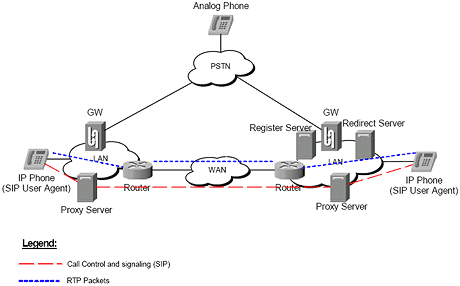SIP Technology Guide
2008-02-22 12:37:54来源:互联网 阅读 ()
 Overview
Overview The Session Initiation Protocol (SIP) is an Internet Engineering Task Force (IETF) standard protocol for establishing, manipulating and tearing down an interactive user session that involves multimedia elements such as audio, video, instant messaging, or other real-time data communications. Even if H.323 was the first protocol that introduces VoIP, annalists estimate that SIP will play a major role in the next years and will replace H.323 in VoIP applications.
SIP is a request-response protocol that works in the Application layer of the Open Systems Interconnection (OSI) communications model, and provides capabilities to:
- Determine the location of the target end point-SIP supports address resolution, name mapping, and call redirection.
- Determine the media capabilities of the target end point-Via Session Description Protocol (SDP); SIP determines the "lowest level" of common services between the end points. Conferences are established using only the media capabilities that can be supported by all end points.
- Determine the availability of the target end point-If a call cannot be completed because the target end point is unavailable, SIP determines whether the called party is already on the phone or did not answer in the allotted number of rings. It then returns a message indicating why the target end point was unavailable.
- Establish a session between the originating and target end point-If the call can be completed, SIP establishes a session between the end points. SIP also supports mid-call changes, such as the addition of another end point to the conference or the changing of a media characteristic or codec.
- Handle the transfer and termination of calls-SIP supports the transfer of calls from one end point to another. During a call transfer, SIP simply establishes a session between the transferee and a new end point (specified by the transferring party) and terminates the session between the transferee and the transferring party. At the end of a call, SIP terminates the sessions between all parties.
SIP Architecture
The SIP architecture identifies two basic components:
- The SIP User Agent (UA) - the endpoint component, which can be represented by a hardware or software device implementing SIP (e.g., an IP phone), and consists of two main components:
- User Agent Client (UAC) - that initiates the calls
- User Agent Server (UAS) - that answers the calls
- The SIP Network Server - handles signaling associated with multiple calls providing name resolution and user location, and it consists of three main groups:
- SIP Register Server - receives registration messages from endpoints regarding current user location and maps the SIP addresses with the physical location(s) in the domain where the endpoint is located. These mapping data are stored in a database, which can reside on the same machine or on a remote server
- SIP Proxy Server - forwards the SIP messages to multiple proxy servers, creating a search tree, in order for the SIP messages to reach their destination. There are two different operating modes for these servers: stateless (the server forgets all the information once the request is sent) and stateful (the server save previous routing information and is able to use it for improving the message transfer)
- SIP Redirect Server - helps endpoints to find the desired address by redirecting them to try another server

本新闻共4页,当前在第1页 1 2 3 4
标签:
版权申明:本站文章部分自网络,如有侵权,请联系:west999com@outlook.com
特别注意:本站所有转载文章言论不代表本站观点,本站所提供的摄影照片,插画,设计作品,如需使用,请与原作者联系,版权归原作者所有
IDC资讯: 主机资讯 注册资讯 托管资讯 vps资讯 网站建设
网站运营: 建站经验 策划盈利 搜索优化 网站推广 免费资源
网络编程: Asp.Net编程 Asp编程 Php编程 Xml编程 Access Mssql Mysql 其它
服务器技术: Web服务器 Ftp服务器 Mail服务器 Dns服务器 安全防护
软件技巧: 其它软件 Word Excel Powerpoint Ghost Vista QQ空间 QQ FlashGet 迅雷
网页制作: FrontPages Dreamweaver Javascript css photoshop fireworks Flash
